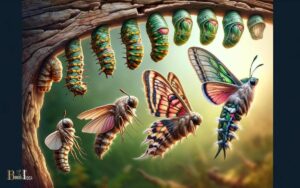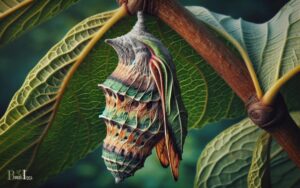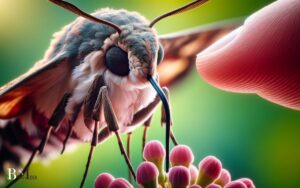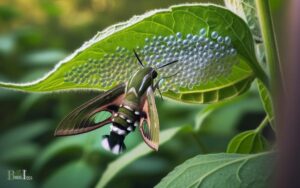Bumblebee Moth Vs Hummingbird Moth: Discover!
When it comes to the natural world, appearances can be deceiving. The bumblebee moth and the hummingbird moth, both often mistaken for their namesake insects, share similarities but also have distinct differences.
These two creatures are often a source of fascination for nature enthusiasts. Understanding the nuances of their physical characteristics, flight patterns, and ecological importance is essential for appreciating their role in the ecosystem.
This brief exploration aims to shed light on the bumblebee moth and hummingbird moth, highlighting their unique features and contributions to the natural world.
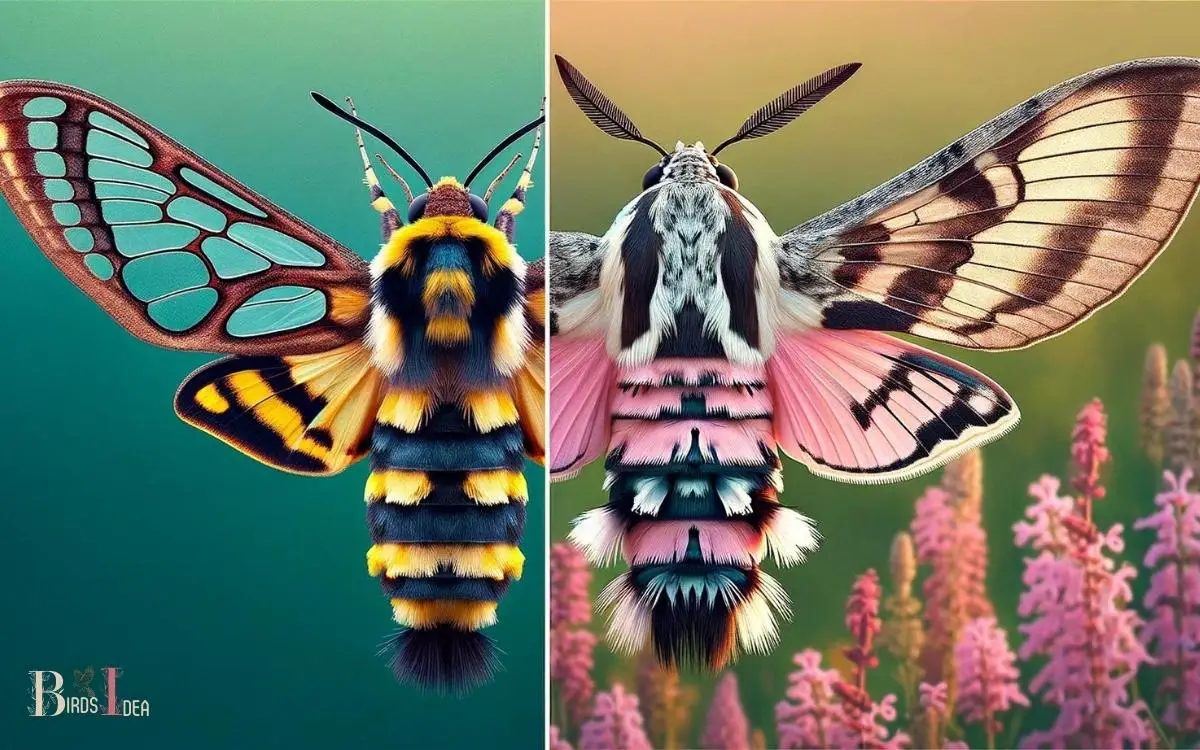
Key Takeaway
Physical Characteristics
The bumblebee moth and the hummingbird moth both possess distinctive physical characteristics that enable them to mimic their namesakes with remarkable accuracy.
These moths have plump, furry bodies with black and yellow stripes, resembling bumblebees, and long, narrow wings that beat rapidly, much like a hummingbird’s.
Their coloration and shape aid in their mimicry, as they hover and dart from flower to flower, sipping nectar with a long proboscis.
Their wings can be transparent or have a slight coloration, further adding to their similarity to hummingbirds.
These physical attributes not only serve as a defense mechanism, protecting them from predators that mistake them for stinging insects, but also make them efficient pollinators, contributing to the ecosystem in a manner similar to their namesakes.
Habitat and Distribution
Both species inhabit a wide range of habitats across North America, including gardens, meadows, and woodland edges.
Bumblebee moths are found in open areas with abundant flowers, such as fields, gardens, and parks. They’re also commonly seen in suburban and urban environments.
Hummingbird moths are distributed throughout the continent, favoring similar habitats to bumblebee moths.
They’re often found in meadows, along woodland edges, and in gardens rich with nectar-producing plants.
Both species are highly adaptable and can thrive in diverse ecosystems, from the southern United States to the boreal forests of Canada.
Their ability to inhabit various environments contributes to their widespread distribution and makes them a familiar sight to many nature enthusiasts across North America.
Life Cycle and Behavior
Inhabiting a wide range of environments across North America, bumblebee moths and hummingbird moths exhibit similar life cycles and behaviors, with distinct adaptations that contribute to their success in diverse ecosystems.
Life Cycle
Both moths undergo complete metamorphosis, progressing from egg to larva, pupa, and adult stages.
The larvae, or caterpillars, feed on a variety of host plants, while the adults primarily feed on nectar from flowers.
Behavior
These moths are diurnal, meaning they’re active during the day. They’re known for their hovering flight patterns while feeding, resembling their namesake insects, bumblebees, and hummingbirds.
Adaptations
Bumblebee moths and hummingbird moths have evolved to mimic the appearance and behaviors of their namesake creatures, providing them with protection from potential predators and allowing them to efficiently forage for nectar.
Pollination Role
Exhibiting efficient pollination behaviors, bumblebee moths and hummingbird moths play a vital role in the reproductive cycle of numerous plant species in their respective habitats.
Albeit similar in their life cycles and behaviors, these moths distinguish themselves through their unique approaches to pollination.
| Pollination Aspect | Bumblebee Moth | Hummingbird Moth |
|---|---|---|
| Foraging Time | Day | Crepuscular |
| Tongue Length | Short | Long |
| Flight Pattern | Erratic | Direct |
Bumblebee moths are diurnal, foraging during the day, while hummingbird moths are crepuscular, active during twilight.
Moreover, bumblebee moths have short tongues suited for accessing nectar in shallow flowers, whereas hummingbird moths possess long tongues enabling them to reach nectar in deep floral tubes.
Additionally, bumblebee moths exhibit erratic flight patterns, while hummingbird moths have a more direct flight path.
These distinct behaviors highlight the specialized pollination roles each moth plays in their ecosystems.
Moving on to the next subtopic, let’s delve into the ‘similarities in appearance.’
Similarities in Appearance
Despite their distinct pollination behaviors, bumblebee moths and hummingbird moths share similar physical characteristics.
These similarities include:
Body Shape
Both moths have robust, furry bodies that resemble bumblebees or hummingbirds at first glance.
This similarity in body shape helps them to evade predators that mistake them for stinging insects or birds.
Wing Patterns
Both moths have clear wings with areas of dark pigmentation, similar to the patterns found on bumblebees and hummingbirds.
These wing patterns not only aid in camouflage but also contribute to their striking resemblance to their namesake insects and birds.
Proboscis Length
Both moths possess long, straw-like proboscises that they use to feed on nectar, resembling the long tongue of a bumblebee or the extended beak of a hummingbird.
This adaptation allows them to access nectar from deep flowers, just like their insect and avian counterparts.
Differences in Flight Patterns
The bumblebee moth and the hummingbird moth exhibit distinct flight patterns. While the bumblebee moth hovers gracefully over flowers, the hummingbird moth darts rapidly from bloom to bloom.
Additionally, the two moths differ in their wing movements, further setting them apart in their aerial behaviors.
Hovering Vs. Darting Flight
One of the key differences in flight patterns between the bumblebee moth and the hummingbird moth is that one hovers while the other darts.
Hovering Flight
The bumblebee moth has a flight pattern that involves hovering around flowers while feeding on nectar.
It can remain suspended in the air, using rapid wingbeats to maintain its position as it gathers nectar from various blooms.
Darting Flight
In contrast, the hummingbird moth darts swiftly from flower to flower, resembling the flight pattern of an actual hummingbird.
It moves quickly and with agility, making brief stops at each flower to feed before darting off again.
Wing Movement Differences
Continuing from the previous subtopic, both the bumblebee moth and the hummingbird moth exhibit distinct differences in their wing movement, directly influencing their unique flight patterns.
The bumblebee moth’s wing movement is characterized by a rapid vibration, creating a distinctive buzzing sound, while it hovers near flowers to feed.
This erratic and rapid wing movement enables it to hover efficiently, allowing it to stay in one spot while it feeds on nectar.
The distinctive buzzing sound it produces serves as a warning to potential predators, mimicking the sound of a bumblebee and deterring them from attacking.
In contrast, the hummingbird moth’s wing movement is smoother and more continuous. Its wings beat at a rapid rate, allowing it to dart swiftly from one flower to another in search of nectar.
This rapid wing beat facilitates its rapid, darting flight, allowing it to cover a large area in a short amount of time.
The continuous wing movement also enables it to maintain a steady flight path, making it easier for the moth to navigate and target specific flowers.
These differences in wing movement showcase how each moth has evolved specialized flight patterns suited to their respective foraging behaviors.
The bumblebee moth’s hovering flight pattern allows it to carefully navigate and feed on flowers, while the hummingbird moth’s rapid and darting flight enables it to quickly locate and collect nectar from a variety of flowers.
These adaptations in flight patterns have allowed both moths to efficiently forage for food and survive in their respective habitats.
Is the Bumblebee Moth Also Harmless Like the Hummingbird Hawk Moth?
Yes, the Bumblebee Moth is also harmless, similar to the Hummingbird Hawk Moth. There is no known hummingbird hawk moth sting information, as they do not sting or pose a threat to humans. Both of these moth species are beneficial pollinators and do not have the ability to sting.
Importance in Ecosystem
These moths play a crucial role in pollination within their respective ecosystems.
- Pollination: Bumblebee moths and hummingbird moths are important pollinators for a variety of flowers and plants. As they feed on nectar, they inadvertently transfer pollen from one flower to another, facilitating the fertilization process.
- Biodiversity: By actively participating in pollination, these moths contribute to the diversity of plant species within their ecosystems. This, in turn, supports the health and stability of the entire ecosystem.
- Food Web: The pollination activities of these moths are essential for the production of fruits and seeds, which serve as food sources for many other animals, thus contributing to the intricate web of life in their respective habitats.
Conclusion
Both the bumblebee moth and hummingbird moth play vital roles in pollination and are essential to the ecosystem.
Their similar appearances and unique flight patterns make them fascinating creatures to observe in their natural habitats.
But one must wonder, in the delicate balance of nature, which is more crucial to the survival of our world?

